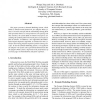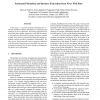WEBI
2005
Springer
15 years 6 months ago
2005
Springer
80
Voted
WEBI
2005
Springer
15 years 6 months ago
2005
Springer
We introduce the concept of community-driven ontology management and demonstrate the added value to conventional ontology management of being community-driven. Further, we present...
WEBI
2005
Springer
15 years 6 months ago
2005
Springer
We analyze typical web portals supporting communication, data sharing and activities of former classmates. The inflexibility and restrictions imposed on users of such portals are ...
93
Voted
WEBI
2005
Springer
15 years 6 months ago
2005
Springer
Web personalization is one of the major concerns of Web intelligence. It is noticed that the two components of Web, users and services, can be understood from multiple views in fo...
WEBI
2005
Springer
15 years 6 months ago
2005
Springer
Structured link vector model (SLVM) is a recently proposed document representation that takes into account both structural and semantic information for measuring XML document simi...
105
Voted
WEBI
2005
Springer
15 years 6 months ago
2005
Springer
This paper presents a Domain Modeling System, which builds a domain model framework for adaptive Web systems. It records concepts and the relationships among them and represents t...
WEBI
2005
Springer
15 years 6 months ago
2005
Springer
As Service Descriptions formalisms increase in maturity, significant issues remain regarding how the description instances will actually be published, �...
77
Voted
WEBI
2005
Springer
15 years 6 months ago
2005
Springer
Image retrieval on the Web requires that important (authoritative) images satisfying the query selection criteria are assigned higher ranking over other relevant images. PicASHOW ...
94
Voted
WEBI
2005
Springer
15 years 6 months ago
2005
Springer
In this paper, we present automated techniques for extracting metadata instance information by organizing and mining a set of news Web sites. We develop algorithms that detect and...
110
click to vote
WEBI
2005
Springer
15 years 6 months ago
2005
Springer
The realization of the Semantic Web needs a set of specialized middleware as its infrastructure. In this paper we describe the principles of tuplespace computing, explain why tupl...



